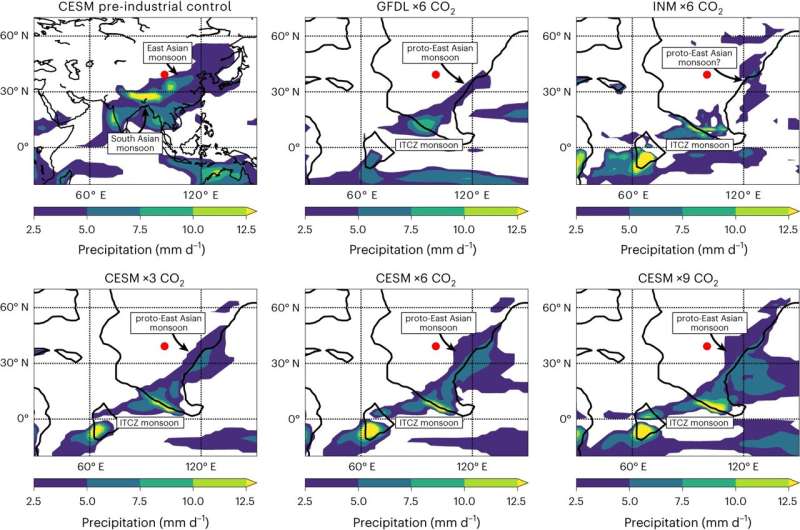This article has been reviewed according to Science X's editorial process and policies. Editors have highlighted the following attributes while ensuring the content's credibility:
fact-checked
peer-reviewed publication
trusted source
proofread
Team investigates vegetation and rainfall in central Asia in early Eocene, finds lessons for Earth's future

As part of the "VeWA" research consortium, researchers from the Senckenberg Biodiversity and Climate Research Center, along with international colleagues, have investigated the precipitation and flora of Central Asia during the Eocene period.
Their study, published today (Jan. 29) in the journal Nature Geoscience, shows that an increase in greenhouse gases in the atmosphere 56 million years ago led to an abrupt change in vegetation. The researchers aim to draw lessons from warm periods in Earth's history for a future shaped by global warming.
Vast, treeless steppes characterize the landscape of Central Asia today. The sparse precipitation that reaches the Asian interior mostly originates from monsoon events in summer or the westerly winds of the mid-latitudes during winter and spring.
"Such grassland steppes are particularly susceptible to the effects of changes in temperature and precipitation—which will have consequences for their inhabitants, such as the Saiga antelope or the endangered Przewalski's horse," explains Dr. Niels Meijer of the Senckenberg Biodiversity and Climate Research Center (SBiK-F). He continues, "One of the great uncertainties of global climate change is how the Asian monsoon and the regions in Central Asia shaped by it will respond to future climate change."
In his latest study, Meijer, together with an international research team, investigated vegetation and rainfall in Central Asia during the early Eocene period between 57 and 44 million years ago. "We hope to gain insights from this particular period of the Earth's history regarding extreme CO2 scenarios in the future. Only if we know and understand the evolution of climate in the past can we improve predictions for the future of modern ecosystems," explains co-author Prof. Dr. Andreas Mulch of the SBiK-F and Goethe University Frankfurt.
In order to reconstruct the precipitation patterns of that time, the researchers used a novel approach in which they combined fossil pollen and spores as well as geochemical data from fossil soils.
"During the period we investigated, precipitation temporarily doubled due to the increased temperatures, and the regional steppe was replaced by a forest landscape," says Meijer. "More importantly, however, we were able to use geochemical data to show that the soils dried out in winter, meaning that, contrary to our expectations, most of the precipitation occurred during the summer months—comparable to the modern monsoon."
Scientists attribute the unusually wet period during the "Paleocene/Eocene temperature maximum" to an expansion of precipitation—so-called proto-monsoons—deep into the Asian interior. The global warm phase at that time was associated with a greatly increased input of greenhouse gases into the Earth's atmosphere and oceans. During this period, global temperatures rose by an average of 6°C within a few thousand years.
"The abrupt greening of the Central Asian steppe desert due to the monsoons likely enabled the spread of new mammal species and may also have played a role in feedback of the global carbon cycle," says Meijer.
"Our work provides paleoclimatic evidence for an abrupt and non-linear response of Asian monsoons to extreme greenhouse conditions. Although the paleogeography of Asia in the Eocene was very different from today, the data highlight the potential for abrupt changes in Central Asian precipitation and ecosystems during future global warming.
"This would be an additional burden for the Central Asian steppe and its flora and fauna, which are already endangered by anthropogenic land use."
More information: Niels Meijer et al, Proto-monsoon rainfall and greening in Central Asia due to extreme early Eocene warmth, Nature Geoscience (2024). DOI: 10.1038/s41561-023-01371-4
Journal information: Nature Geoscience




















